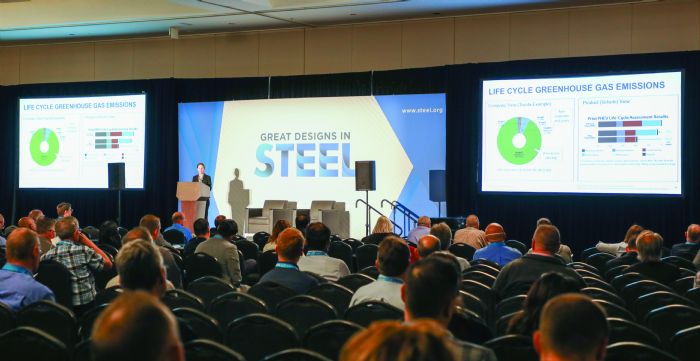New AISI-Automotive Leader
The 2023 event will be the first GDIS with Kristock leading AISI’s automotive program, having taken over in June of 2022 following the retirement of John Catterall. In this position, Kristock is responsible for leadership of the Automotive Applications Council, a group of member steel producers, to oversee automotive research, education and technology-transfer activities such as GDIS.
Prior to arriving at AISI, Kristock served as a scientist, manufacturing engineer and quality-assurance leader. He has served as vice president, quality and product development, at Severstal North America and as co-chair of its international global technology system. His career experience also includes quality assurance, product development, advanced engineering, technical service, process engineering, metallurgy, steelmaking and casting in both basic-oxygen-furnace and electric-arc-furnace operations. Kristock holds a degree in Metallurgical Engineering from Wayne State University, Detroit, MI, and is a past chair of AISI’s Committee on Manufacturing Technology and a Life Member of the Association for Iron and Steel Technology. He also holds International Automotive Task Force auditor certifications.
“AISI is a catalyst for engaging the steel industry to conduct research, provide technology transfer and promote steel-intensive solutions in the auto market,” said Kristock upon his hiring. “I am excited to be part of the automotive program and look forward working with the automotive industry to sustain the safety and durability of cars while reducing environmental impacts.”
Offering more specifics on the coatings discussions at GDIS 2023, Kristock tells MetalForming that some abstracts indicate presentations that focus on press hardening and coating types that have less requirements for post-hot stamping treatment than others.
“Recently developed coatings,” he says, “are more robust and can withstand variances in heating, where some of the zinc coatings, to work properly, require a very tight window of heating. We’re also seeing new developments in zinc-based coatings that the automotive industry may someday incorporate. We focus on preparations needed to provide these coatings, which are in use overseas.”
Tier Experience Brought to Bear
AISI efforts such as offering GDIS seek to push materials-technology developments toward the manufacturing mainstream by educating OEMS and Tier suppliers on processing techniques, and Kristock feels that his extensive experience in both steel and its processing can help.
“I've been a Tier-One supplier to the automotive industry for all of my 40-some years in the business,” he says, “so I have great respect for what automakers require and what they need from supplier industries as well as suppliers themselves. And, this experience gives me a lot of insight. I'm trying to make sure that we're connecting on a superior technical level with the automotive-body-structures groups to show them the advances in steels, and educate them on how these advances come about—through robust development efforts.
“There's a large number of proprietary manufacturing and processing technologies now available,” Kristock continues, “and one AISI project, for example, seeks to integrate new steel grades with these technologies in order to make cost-efficient manufacturing proposals to automotive. AISI seeks to define, develop and communicate innovations, which then can take off on their own as manufacturing principles. We're not advocating for any one particular processor or supplier of technology, but as a whole in combination with steel.”
From such over-arching missions, Kristock drills down on specific projects such as designing proposals for steel-intensive bumper systems and battery enclosures.
“Bumper systems and battery enclosures have in a sense gravitated in the aluminum direction due to their application in the initial premium aluminum-intensive EVs,” he offers. “Tier manufacturers now hear from automakers a desire to improve cost performance as well as sustainability—both well-served by steel. So, we need to propose some functional steel-intensive alternatives to the marketplace for acceptance in design, and we’re working on that.”
Another area where Kristock hopes to capitalize on his steel-processor experience: He sees a broad opportunity for information on the nuances of processing AHSS on the shop floor. One example: “While working at a blanking company,” he recalls, “I noticed that operators were attempting to manually fold AHSS blank scrap and sometimes jump on it to make it easier to toss into a scrap bin. That, for me, was a safety concern on a detail of AHSS consumption, and the experience was emblematic of the need for education on this and other opportunities related to working efficiently with AHSS.”
As a result, AISI is creating a website to collect available training for metal formers and other steel processors to enable improved shop-floor practices with AHSS. Look for availability by the end of 2023, according to Kristock. Also in the works this year, a searchable online database of past GDIS presentations owing to requests from automotive engineers.
Focus on Sustainability
With GDIS 2023 rapidly finalizing, and so many AISI-automotive projects in the works, there’s plenty to report on, but we’d be remiss if we didn’t discuss sustainability.
“One of the great unknowns about steel as a material for automotive manufacturing—the U.S. steel industry is a global leader in terms of addressing greenhouse-gas emissions,” Kristock offers. “Our technologies and technical improvements in steel-making processes make us the world's lowest emitter. In addition, we’re working with many decarbonization initiatives including the potential, when it becomes available, of how to integrate more hydrogen into our steel-mill operations.”
Increasing U.S. investment in direct-reduced-iron technology and facilities provides for a win-win, in decarbonization and domestic steel-making self-sufficiency, and is a message that AISI and Kristock want everyone to know. MF
See also: American Iron and Steel Institute
Technologies: Management
 An expected 1300 GDIS attendees will, through the presentations, Q&A, lunch and break periods, and supplier exhibits, have the opportunity to interact and network with executives, engineers and automotive designers from around the world.
An expected 1300 GDIS attendees will, through the presentations, Q&A, lunch and break periods, and supplier exhibits, have the opportunity to interact and network with executives, engineers and automotive designers from around the world. “I would like to see a variety and detail in the displays so that, for example, engineers focused on structural design can see a different aspect of their work in play,” Kristock says.
“I would like to see a variety and detail in the displays so that, for example, engineers focused on structural design can see a different aspect of their work in play,” Kristock says.






